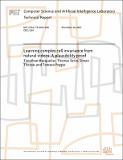| dc.description.abstract | One of the most striking feature of the cortex is its ability to wire itself. Understanding how the visual cortex wires up through development and how visual experience refines connections into adulthood is a key question for Neuroscience. While computational models of the visual cortex are becoming increasingly detailed, the question of how such architecture could self-organize through visual experience is often overlooked. Here we focus on the class of hierarchical feedforward models of the ventral stream of the visual cortex, which extend the classical simple-to-complex cells model by Hubel and Wiesel (1962) to extra-striate areas, and have been shown to account for a host of experimental data. Such models assume two functional classes of simple and complex cells with specific predictions about their respective wiring and resulting functionalities.In these networks, the issue of learning, especially for complex cells, is perhaps the least well understood. In fact, in most of these models, the connectivity between simple and complex cells is not learned butrather hard-wired. Several algorithms have been proposed for learning invariances at the complex cell level based on a trace rule to exploit the temporal continuity of sequences of natural images, but very few can learn from natural cluttered image sequences.Here we propose a new variant of the trace rule that only reinforces the synapses between the most active cells, and therefore can handle cluttered environments. The algorithm has so far been developed and tested at the level of V1-like simple and complex cells: we verified that Gabor-like simple cell selectivity could emerge from competitive Hebbian learning. In addition, we show how the modified trace rule allows the subsequent complex cells to learn to selectively pool over simple cells with the same preferred orientation but slightly different positions thus increasing their tolerance to the precise position of the stimulus within their receptive fields. | en_US |
